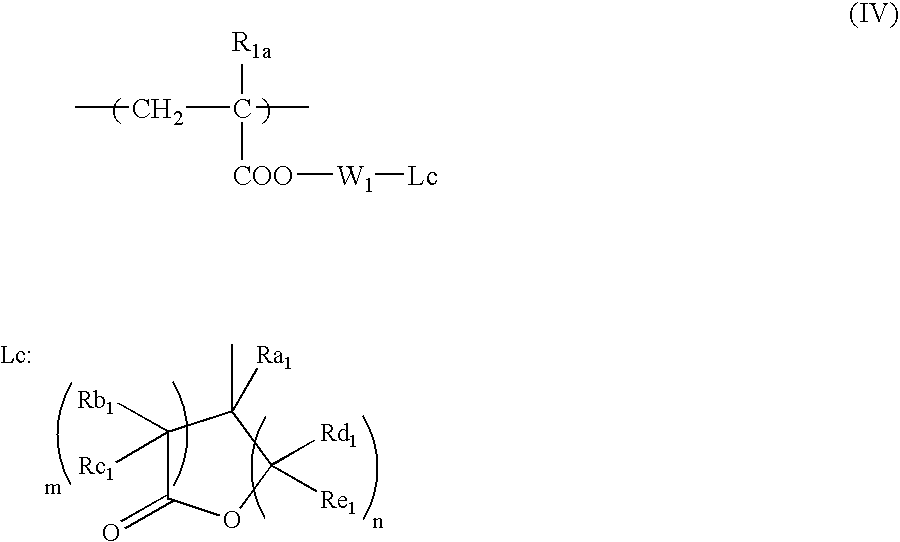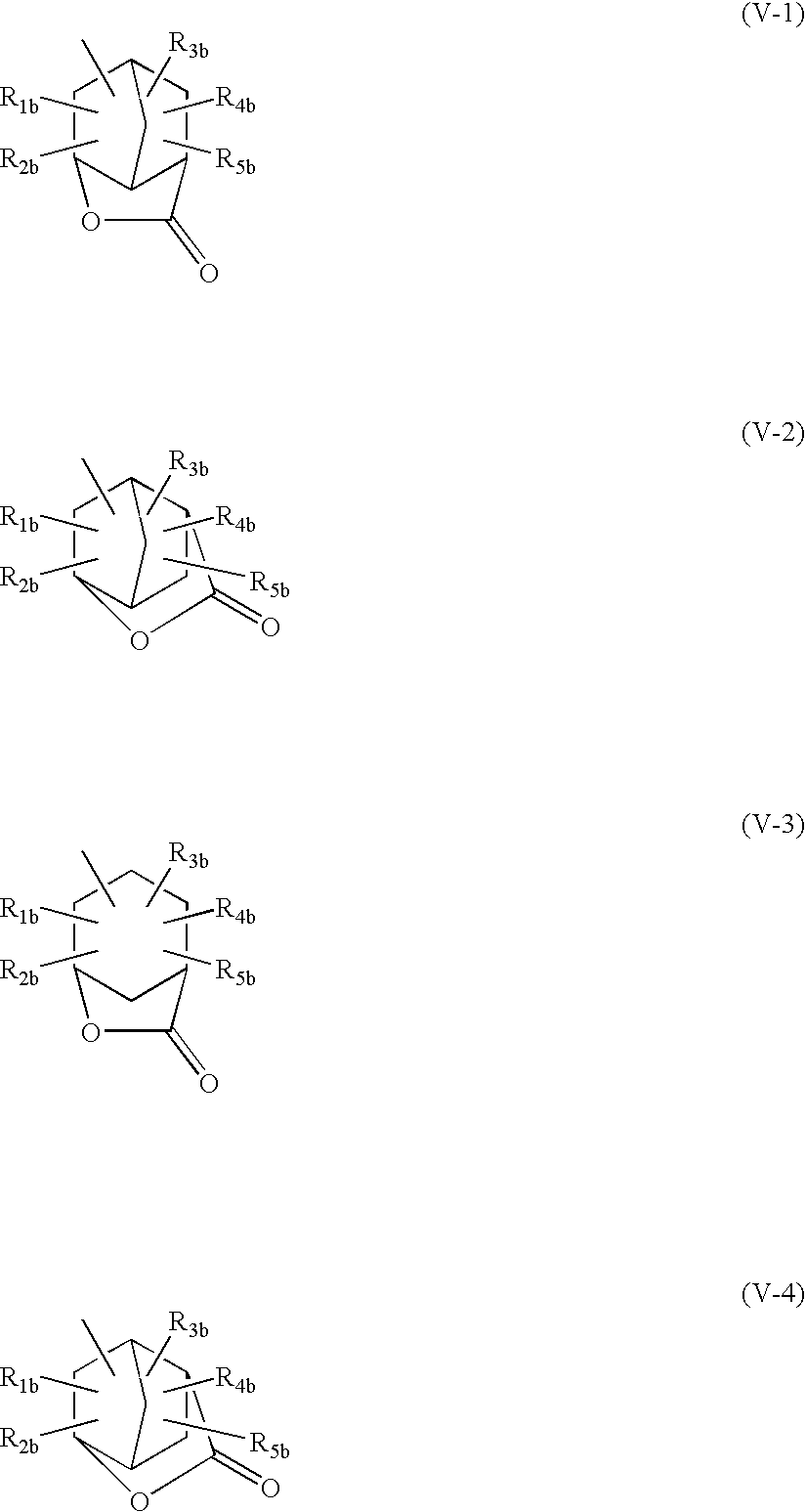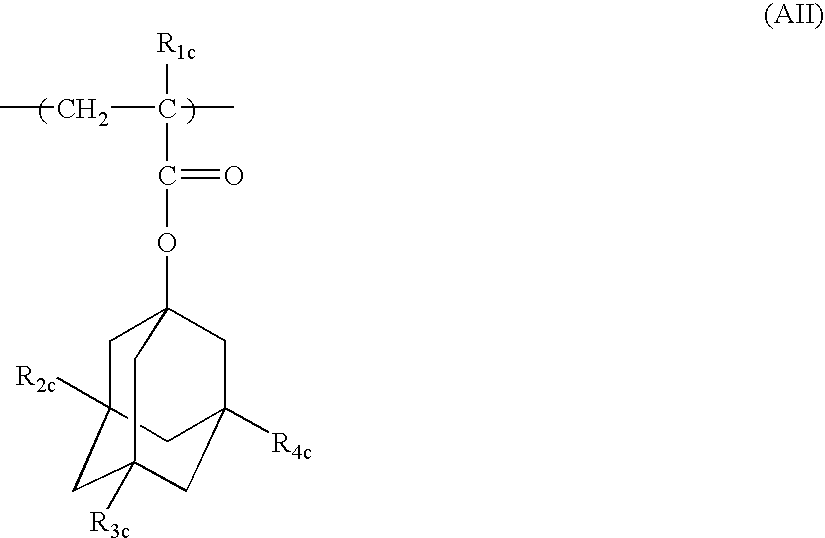Positive resist composition
a technology of composition and resist, applied in the direction of photosensitive materials, photomechanical equipment, instruments, etc., can solve the problems of reducing yield, affecting the effect of electric characteristics, and not satisfying the composition of amplification resist, so as to reduce the roughness of the line edg
- Summary
- Abstract
- Description
- Claims
- Application Information
AI Technical Summary
Benefits of technology
Problems solved by technology
Method used
Image
Examples
synthesis example 1
Synthesis of Resin (1-1)
[0312]In a reaction vessel, 2-norbornyl-2-propyl methacrylate, 3,5-dihydoxy-1-adamantyl methacrylate and cyclohexane lactone acrylate were placed in proportions of 40:20:40 and dissolved in a 60:40 mixture of propylene glycol monomethyl ether acetate and propylene glycol monomethyl ether, thereby preparing 450 g of a solution having a solids concentration of 22%. This solution was mixed with 1 mole % of V-601 produced by Wako Pure Chemical Industries, Ltd., and then added dropwise to 50 g of a 60:40 mixture of propylene glycol monomethyl ether acetate and propylene glycol monomethyl ether heated to 100° C. over a period of 6 hours in an atmosphere of nitrogen.
[0313]After the completion of the addition, the reaction solution was stirred for additional 2 hours. At the conclusion of the reaction, the resultant solution was cooled to room temperature, and poured into 5 liters of a 9:1 mixture of hexane and ethyl acetate. A white powdery matter thus deposited was ...
synthesis example 2
Synthesis of Resin (2-1)
[0315]Polymerization was carried out using the same method as in Synthesis Example 1, and the intended Resin (2-1) was obtained.
[0316]The ratio (by mole) of the repeating units a, b and c (illustrated hereinafter) in the resin was a:b:c=38:22:40 as determined by C13-NMR. The weight average molecular weight and the dispersion degree of the resin were 8,330 and 2.1, respectively, as measured by GPC and calculated in terms of standard polystyrene. As a result of DSC measurement, the glass transition temperature of Resin (2-1) was found to be 131° C.
synthesis example 3
Synthesis of Resin (3-1)
[0317]In a reaction vessel, 2-adamantyl-2-propyl methacrylate, dihydoxyadamantyl methacrylate and norbornane lactone acrylate were placed in proportions of 40:20:40 and dissolved in a 60:40 mixture of propylene glycol monomethyl ether acetate and 3-methoxy-1-butanol, thereby preparing 450 g of a solution having a solids concentration of 22%. This solution was mixed with 8 mole % of V-601 produced by Wako Pure Chemical Industries, Ltd., and then added dropwise to 50 g of a 60:40 mixture of propylene glycol monomethyl ether acetate and 3-methoxy-1-butanol heated to 120° C. over a period of 6 hours in an atmosphere of nitrogen. After the completion of the addition, the reaction solution was stirred for additional 2 hours. At the conclusion of the reaction, the resultant solution was cooled to room temperature, and poured into 5 liters of a 9:1 mixture of hexane and ethyl acetate. A white powdery matter thus deposited was recovered by filtration as the intended R...
PUM
| Property | Measurement | Unit |
|---|---|---|
| glass transition temperature | aaaaa | aaaaa |
| glass transition temperature | aaaaa | aaaaa |
| glass transition temperature | aaaaa | aaaaa |
Abstract
Description
Claims
Application Information
 Login to View More
Login to View More - R&D
- Intellectual Property
- Life Sciences
- Materials
- Tech Scout
- Unparalleled Data Quality
- Higher Quality Content
- 60% Fewer Hallucinations
Browse by: Latest US Patents, China's latest patents, Technical Efficacy Thesaurus, Application Domain, Technology Topic, Popular Technical Reports.
© 2025 PatSnap. All rights reserved.Legal|Privacy policy|Modern Slavery Act Transparency Statement|Sitemap|About US| Contact US: help@patsnap.com



